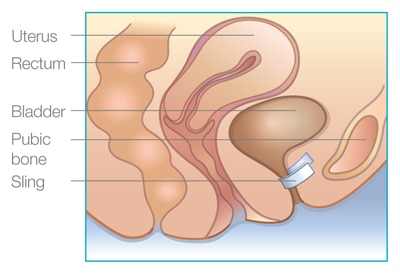Surgical treatments for incontinence may include open bladder neck suspensions, and sling procedures. A sling procedure may be prescribed by your doctor that places a small strip of synthetic or biologic material beneath the urethra. Like a backboard, it supports the urethra during activities that put a strain on the area and prevent leakage from occurring.

Are there any risks?
Like any surgery, there are some risks related to the procedure.
These include:
- Vaginal extrusion
- Erosion (e.g., vaginal, urethral)
- Dyspareunia (i.e., painful intercourse)
- Sling migration
- Infection
- Pain
- Hematoma
- Scarring
- Transient or permanent urinary retention/obstruction
- Urethral obstruction
- Voiding dysfunction
- Nerve injury
- Vascular injury
- Bladder, bowel, urethra, vessel and/or nerve perforation
Talk to your doctor to discuss these risks in detail.
The mesh used to correct incontinence may cause pain. You may also be able to feel the mesh inside of the vagina. When this occurs, it can interfere with intimate sexual activity. You may also experience an increased need to urinate, or your urine flow may be slower.
You may also not be able to urinate naturally following the procedure. This could be temporary, but it may last a month or longer. If this occurs, a catheter will be inserted to help you urinate, or you may need another operation to have the sling clipped or cut. Depending on how severe the symptoms are, further surgery may be necessary.
Another potential risk is having a reaction to the sling material itself, or getting an infection that requires treatment with antibiotics. Talk to your doctor about all these risks and reactions.
It’s a good idea to really understand and consider all the potential risks as well as the benefits of a permanent implant when you choose a treatment option.